牛津译林版英语八上Unit 8《Natural》(integrated skills)ppt课件4
牛津译林版英语八上Unit 8《Natural》(task)教学设计
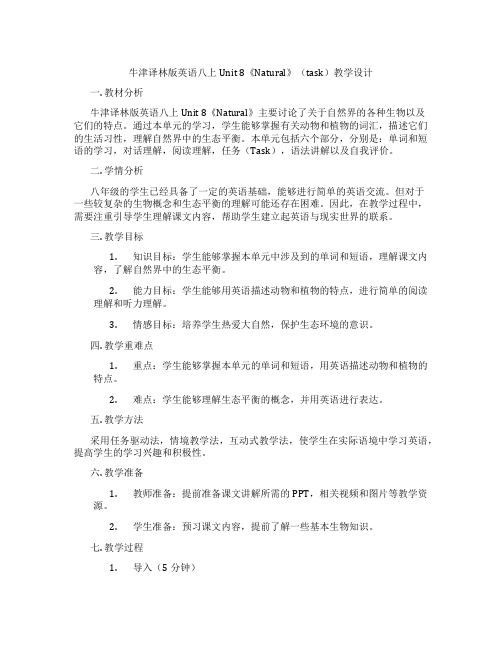
牛津译林版英语八上Unit 8《Natural》(task)教学设计一. 教材分析牛津译林版英语八上Unit 8《Natural》主要讨论了关于自然界的各种生物以及它们的特点。
通过本单元的学习,学生能够掌握有关动物和植物的词汇,描述它们的生活习性,理解自然界中的生态平衡。
本单元包括六个部分,分别是:单词和短语的学习,对话理解,阅读理解,任务(Task),语法讲解以及自我评价。
二. 学情分析八年级的学生已经具备了一定的英语基础,能够进行简单的英语交流。
但对于一些较复杂的生物概念和生态平衡的理解可能还存在困难。
因此,在教学过程中,需要注重引导学生理解课文内容,帮助学生建立起英语与现实世界的联系。
三. 教学目标1.知识目标:学生能够掌握本单元中涉及到的单词和短语,理解课文内容,了解自然界中的生态平衡。
2.能力目标:学生能够用英语描述动物和植物的特点,进行简单的阅读理解和听力理解。
3.情感目标:培养学生热爱大自然,保护生态环境的意识。
四. 教学重难点1.重点:学生能够掌握本单元的单词和短语,用英语描述动物和植物的特点。
2.难点:学生能够理解生态平衡的概念,并用英语进行表达。
五. 教学方法采用任务驱动法,情境教学法,互动式教学法,使学生在实际语境中学习英语,提高学生的学习兴趣和积极性。
六. 教学准备1.教师准备:提前准备课文讲解所需的PPT,相关视频和图片等教学资源。
2.学生准备:预习课文内容,提前了解一些基本生物知识。
七. 教学过程1.导入(5分钟)利用图片和视频引导学生进入主题,激发学生对自然界生物的兴趣。
例如,展示一些动物和植物的图片,让学生猜测它们的名字和特点。
2.呈现(10分钟)教师通过PPT呈现本节课的主要内容,包括单词和短语的学习,对话理解,阅读理解等。
在这个过程中,教师可以用生动的语言和丰富的表情动作来吸引学生的注意力。
3.操练(15分钟)学生分组进行对话练习,模拟实际场景,如在公园、动物园等地方用英语交流有关动物和植物的话题。
牛津译林版初二英语八年级上册8A Unit 8 Natural disasters课件

The earthquake hit Yangzhou last summer
Mr Ding’s story
I was sick in hospital last summer. I was lying in bed when earthquake happened, my wife was looking after me, my daughter was watching TV at home with her grandparents. At that time I felt a slight shake, I heard the people outside scream in fear. I saw the people in the street run in all directions through the window. At first I was very nervous , my heart was beating fast . But after a short while, I found everything was OK. I’m not afraid at all, my wife asked me to calm down, because we are still alive, we are safe.
Ⅱ Pre-reading 2
Background of Taiwan Earthquake
There was an earthquake in Taiwan. It happened on 21st September 1999. 12,000 buildings fell down . 1,700 people died. Timmy survived the earthquake. He wrote his story and put it on his home page.
牛津译林版英语八上Unit 8《Natural》(Reading1)ppt课件2

The Taiwan earthquake
It happened on September 21st , 1999, 150km south-west of Taibei. More than 1,700 people died . Over 8,700 people were injured(受伤). 12,000 buildings were destroyed and 100,000 people were left homeless. It is believed to be the strongest earthquake in Taiwan last century.
F F
6. People found Timmy soon after he
was trapped.
Read paragraph 1 Complete the table. At first
When it was
About two o’clock in the early morning. He was sleeping. He heard a loud noise like thunder. He felt a slight shake.
flood
Hint 1
always coming with strong wind
Hint 2
in Beijing
Hint 3
making the air polluted
Hint 4
bringing sand and dust
sandstorm
Hint 1
crazy animals
Hint 2
What he did
What he heard How he felt
牛津译林版英语八上Unit 8《Natural》(Reading1)ppt课件

15快速的跳动 beat fast 16 被困住 be trapped 17 自言自语 say to oneself 18 一阵恐惧 a moment of fear 19 穿过我的脑海 go through my mind 20告诉我自己冷静下来 tell myself to calm down 21 仍然活着 be still alive
22 开始崩塌 begin to come down 23 大喊求救 shout for help 24在黑暗中慢慢地向前移动身体 pull myself slowly through the dark 25试着找到我的出路 try to find my way out 26 听到我上面的嘈杂声 hear some noise above me 27听到人们兴奋的喊声 hear shouts from the excited people 28 移开 move away
8 跑出大楼 run out of the building 9尽我的全力跑出去 try my best to run out 10竭尽全力做某事 try one’s best to do sth. 11四处奔跑 run in all directions 12玻璃碎片和砖块 pieces of glass and bricks 13掉下来 fall down 14 感到紧张 feel nervous
29 明亮的日光 bright daylight 30 安全 be safe 31 向一个方向跑 run in the same direction
Match the words on the left with the meanings on the right. a finally 1 shake b fall to the ground 2 scream c give a loud high cry 3 come down d not in danger e move quickly from 4 silent side to side, up and 5 at last down, etc. 6 safe f quiet
牛津译林初中八年级英语上册 Unit 8 Natural disasters reading 2课件

▪ start to shake
shake one’s head
v.
shake down the apples
shake v.& n.
shaking n.
shook
1) At first, the slight __s_h_a__k_e_/_s_h_a__k_in_gof the house made Timmy frightened.
11. … I told myself to calm down …(line12) calm down 冷静下来,平静下来
calm v. 使平静,使镇静 n. 平静,宁静 adj. 平静的,镇静的
e.g. Just calm down a bit! 你先静一静!
Can you translate the following sentences?
e.g. People screamed in fear. 人们害怕地尖叫起来。
e.g. They got lost in the forest. They had to try different ways in fear. 他们在森林里迷路了,他们不得不害 怕地尝试不同的路。
5. Some ran out of the building. (line5) run out of … 从……跑出 e.g. Some students run out of the classroom.
Fill in the blanks with the correct words or phrases:
shake fall down scream in fear in all directions
try one’s best to protect calm down
牛津译林版英语八上Unit 8《Natural》(grammar)ppt课件2

Were they teaching English? No, they were not teaching English.
We use the past continuous tense to talk about things that were happening at a particular time in the
What is Tom doing? Tom is playing football.
What is Lucy doing?
Lucy is read ing a book.
Present continuous tense be (am/is/are) + verb-ing
What was Tom doing at that moment? Tom was playing football.
பைடு நூலகம்
• watch TV
• read books • practise swimming • watch the parade 5. from 9 to 10 last night • make cakes
过去进行时的句式
1) 基本结构:was/were + Ving 2) 肯定句: 主语 + was/ were + Ving
She was drinking milk at this time yesterday.
She was playing computer games at that time.
He was reading newspaper from 10 to 11 yesterday morning.
牛津译林版八年级英语上册Unit 8《Natural》(task)精品课件
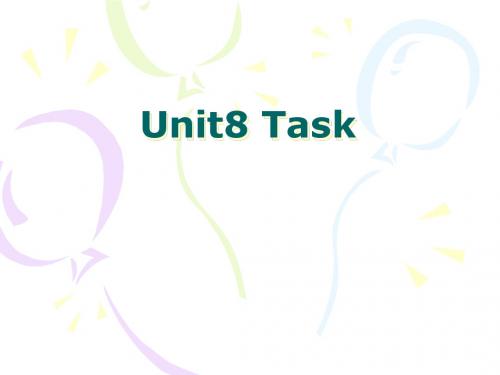
The weather was really terrible. The ______ snow kept falling around us. We could hear the _____ wind blowing. Suddenly, a strong wind came from behind. I lost my _________ umbrella in the wind and I nearly ____ fell over. We had to walk slowly in the deep snow. When we arrived at the bus stop, we saw many people ________ waiting there.
Unit8 Task
1 一月五号,星期五,一场暴风雪袭击了北京。 A snowstorm hit Beijing on Friday, 5 January. 2 我正在教室里做家庭作业,这时吴老师走进 来叫我们早点回家。 I was doing my homework in the classroom when Mr. Wu came in and told us to go home early.
floods
thunder and lightning
rainstorms
drought (旱灾)
fires
snowstorms
clear the snow
清除,清理
He nearly fell over.
将近,几乎
Writing about a natural disaster
Sandy is writing an article for the
5 天气真是糟糕。雪在我们的周围不停地下着。
牛津译林版英语八上《Unit8Naturaldisasters》词组句子练习
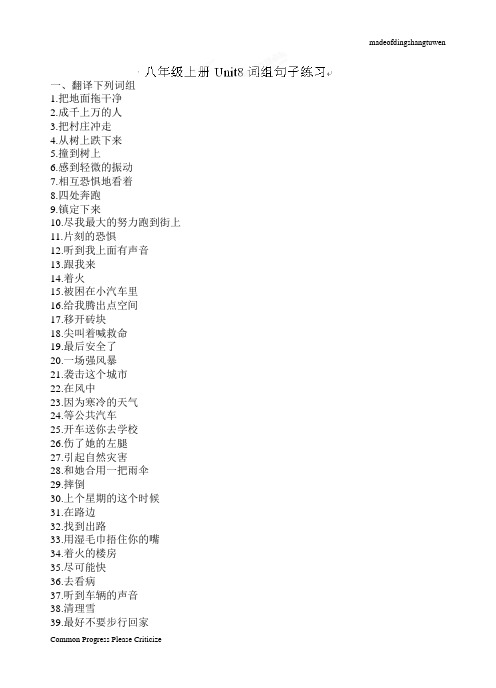
一、翻译下列词组1.把地面拖干净2.成千上万的人3.把村庄冲走4.从树上跌下来5.撞到树上6.感到轻微的振动7.相互恐惧地看着8.四处奔跑9.镇定下来10.尽我最大的努力跑到街上11.片刻的恐惧12.听到我上面有声音13.跟我来14.着火15.被困在小汽车里16.给我腾出点空间17.移开砖块18.尖叫着喊救命19.最后安全了20.一场强风暴21.袭击这个城市22.在风中23.因为寒冷的天气24.等公共汽车25.开车送你去学校26.伤了她的左腿27.引起自然灾害28.和她合用一把雨伞29.摔倒30.上个星期的这个时候31.在路边32.找到出路33.用湿毛巾捂住你的嘴34.着火的楼房35.尽可能快36.去看病37.听到车辆的声音38.清理雪39.最好不要步行回家40.花时间练习弹钢琴二、翻译下列句子1.鸟儿朝四面八方飞去了。
2.要使兴奋的足球迷们平静下来是很困难的。
3.那些年轻妇女被困在熊熊燃烧着的大楼里4.昨天晚上我直到做完作业才睡觉。
5.既然大家都在这里,我想谈谈这次考试的事情。
6.我们应尽力帮助需要帮助的人。
7.我个子不够高,够不着桌上的苹果。
8.考试时冷静下来很重要。
9.几小时后他找到了出路。
10.幸运地是刚好有足够的空间让我移动。
11.昨天我到家时,我爸爸妈妈正在吃晚饭。
12.他看电视时,我在看书。
13.天将下雪,温度将降到零下5度。
14.不要四处乱跑,我们应该保持镇定。
15.那个房子着火了,因为闪电击中了它。
16.他们的车撞上了一棵树,幸好没人受伤。
17.在我前往他们学校的路上,我的小汽车出了故障。
18.我们该做些什么来保护自己免受交通事故的伤害?19.一场大雨阻止他们回家。
20.我在清理桌子时,发现了那支钢笔。
八年级上册Unit8词组句子练习一、翻译下列词组1.把地面拖干净mop the floor up2.成千上万的人thousands of people3.把村庄冲走wash the village away4.从树上跌下来fall from a tree5.撞到树上crash into a tree6.感到轻微的振动feel a slight shaking7.相互恐惧地看着look at each other in fear8.四处奔跑run in all directions9.镇定下来calm down10.尽我最大的努力跑到街上try my best to run out to the street11.片刻的恐惧the moment of fear12.听到我上面有声音hear some noise above me13.跟我来come with me14.着火catch fire15.被困在小汽车里be trapped in the car16.给我腾出点空间make some space for me17.移开砖块move away the bricks18.尖叫着喊救命scream for help19.最后安全了be safe at last20.一场强风暴 a heavy storm21.袭击这个城市hit the city22.在风中in the wind23.因为寒冷的天气because of the cold weather24.等公共汽车wait for a bus25.开车送你去学校drive you to school26.伤了她的左腿hurt her left leg27.引起自然灾害cause natural disasters28.和她合用一把雨伞share an umbrella with him29.摔倒fall over30.上个星期的这个时候this time last week31.在路边on the side of the road32.找到出路find one’s way out33.用湿毛巾捂住你的嘴cover your mouth with a wet towel34.着火的楼房the building on fire35.尽可能快as quickly as possible36.去看病go to see a doctor37.听到车辆的声音hear the noise of traffic38.清理雪clear the snow39.最好不要步行回家had better not go home on foot40.花时间练习弹钢琴spend some time practicing playing the piano二、翻译下列句子1.鸟儿朝四面八方飞去了。
牛津译林版英语八上Unit 8《Natural》(integrated skills)教学设计
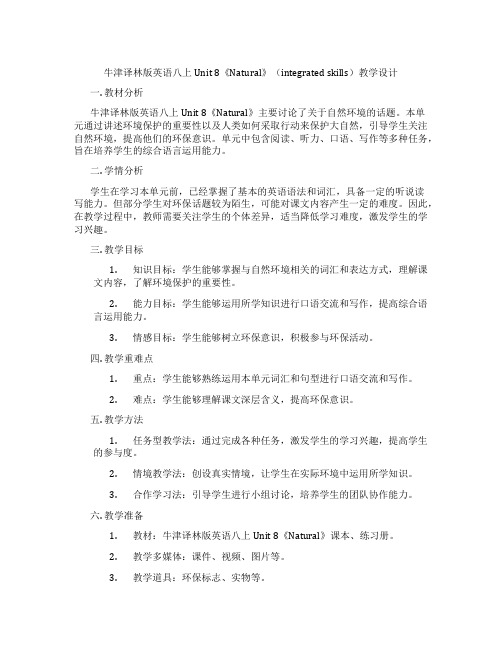
牛津译林版英语八上Unit 8《Natural》(integrated skills)教学设计一. 教材分析牛津译林版英语八上Unit 8《Natural》主要讨论了关于自然环境的话题。
本单元通过讲述环境保护的重要性以及人类如何采取行动来保护大自然,引导学生关注自然环境,提高他们的环保意识。
单元中包含阅读、听力、口语、写作等多种任务,旨在培养学生的综合语言运用能力。
二. 学情分析学生在学习本单元前,已经掌握了基本的英语语法和词汇,具备一定的听说读写能力。
但部分学生对环保话题较为陌生,可能对课文内容产生一定的难度。
因此,在教学过程中,教师需要关注学生的个体差异,适当降低学习难度,激发学生的学习兴趣。
三. 教学目标1.知识目标:学生能够掌握与自然环境相关的词汇和表达方式,理解课文内容,了解环境保护的重要性。
2.能力目标:学生能够运用所学知识进行口语交流和写作,提高综合语言运用能力。
3.情感目标:学生能够树立环保意识,积极参与环保活动。
四. 教学重难点1.重点:学生能够熟练运用本单元词汇和句型进行口语交流和写作。
2.难点:学生能够理解课文深层含义,提高环保意识。
五. 教学方法1.任务型教学法:通过完成各种任务,激发学生的学习兴趣,提高学生的参与度。
2.情境教学法:创设真实情境,让学生在实际环境中运用所学知识。
3.合作学习法:引导学生进行小组讨论,培养学生的团队协作能力。
六. 教学准备1.教材:牛津译林版英语八上Unit 8《Natural》课本、练习册。
2.教学多媒体:课件、视频、图片等。
3.教学道具:环保标志、实物等。
七. 教学过程1.导入(5分钟)利用图片或视频展示自然环境的美丽和破坏,引导学生关注自然环境,激发学生的学习兴趣。
2.呈现(10分钟)老师带领学生朗读课文,边读边解释生词和短语,让学生对课文内容有一个整体的认识。
3.操练(15分钟)学生进行小组讨论,讨论如何保护自然环境。
老师巡回指导,纠正发音和语法错误。
牛津译林版英语八上unit8复习教案
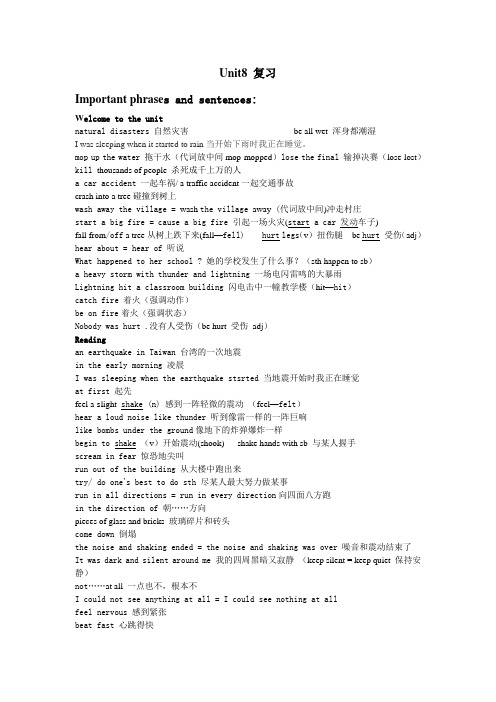
Unit8 复习Important phrase s and sentences:W elcome to the unitnatural disasters 自然灾害be all wet 浑身都潮湿I was sleeping when it started to rain当开始下雨时我正在睡觉。
mop up the water 拖干水(代词放中间mop-mopped)lose the final 输掉决赛(lose-lost)kill thousands of people杀死成千上万的人a car accident 一起车祸/ a traffic accident一起交通事故crash into a tree碰撞到树上wash away the village = wash the village away (代词放中间)冲走村庄start a big fire = cause a big fire 引起一场火灾(start a car 发动车子)fall from/off a tree从树上跌下来(fall—fell) hurt legs(v)扭伤腿be hurt 受伤(adj)hear about = hear of 听说What happened to her school ? 她的学校发生了什么事?(sth happen to sb)a heavy storm with thunder and lightning 一场电闪雷鸣的大暴雨Lightning hit a classroom building 闪电击中一幢教学楼(hit—hit)catch fire 着火(强调动作)be on fire着火(强调状态)Nobody was hurt .没有人受伤(be hurt 受伤adj)Readingan earthquake in Taiwan 台湾的一次地震in the early morning 凌晨I was sleeping when the earthquake stsrted 当地震开始时我正在睡觉at first 起先feel a s light shake (n) 感到一阵轻微的震动(feel—felt)hear a loud noise like thunder 听到像雷一样的一阵巨响like bombs under the ground像地下的炸弹爆炸一样begin to shake (v)开始震动(shook) shake hands with sb 与某人握手scream in fear 惊恐地尖叫run out of the building 从大楼中跑出来try/ do one’s best to do sth 尽某人最大努力做某事run in all directions = run in every direction向四面八方跑in the direction of 朝……方向pieces of glass and bricks玻璃碎片和砖头come down 倒塌the noise and shaking ended = the noise and shaking was over 噪音和震动结束了It was dark and silent around me 我的四周黑暗又寂静(keep silent = keep quiet 保持安静)not……at all 一点也不,根本不I could not see anything at all = I could see nothing at allfeel nervous 感到紧张beat fast 心跳得快be trapped 被困住;处于困境中= be in troublesay to oneself 自言自语a moment of fear 片刻的恐惧go through one’s mind 掠过脑海calm down (代词放中间) 镇定下来、平静下来calm sb down 使某人冷静下来be still alive 仍然活着= still stay aliveshout/scream for help呼喊求救pull oneself slowly through the dark 慢慢地向前移动通过黑暗Luckily, there was just enough space for me to move 很庆幸,刚好有足够的空间使我能够挪动find one’s way out 找到出路hear shouts from excite d people 听到人们兴奋的叫喊声move away the bricks 搬走砖块(代词放中间)see the bright daylight 看见明亮的日光(shine brightly 明亮照耀)at last = finally = in the end 最后be asleep 睡着的–fall asleep 入睡,睡着—feel sleepy 感到瞌睡—the sleeping boy 正在睡觉的男孩Grammar and Integrated skillsWhat a terrible snowstorm ! 多么可怕的暴风雪啊!on the side of the road 在马路边wait for a taxi 等出租车break down 出故障,抛锚(break--broke)because of the cold weather 由于寒冷的天气because of (doing) sth 由于(做)某事(后接短语,而because后接一个句子)ring sb to come and help 打电话叫某人来帮忙hide behind a tree 躲在树后(hide—hid)get out as soon as possible 尽可能快地出去尽可能(2种)as soon as possible = as soon as sb canCover your mouth and noses with a wet towel to protect yourself from thick smoke 用一条湿毛巾捂住你的嘴和鼻子来保护你自己免遭浓烟protect sb from……保护某人免遭……伤害stay low to the ground 贴着地面Never go back into the building on fire 不要返回到着火某的大楼Do not walk through the flood water 不要走过洪水Hide under a strong desk 躲在坚固的课桌下follow traffic rules 遵守交通规则ride your bicycle on railways 在铁路上骑自行车keep ourselves safe from traffic accidents 使我们自己安全免遭交通事故(keep sb safe from)stay away from a window 远离窗户deal with some accidents 处理一些事故burn our hands 烫伤我们的手put your hand in cold water 把手放入冷水put some cream on the burn 在伤口上涂上膏药Study skills and Taskon weekdays 在工作日have (got) a headache/ toothache头痛/牙痛The snow kept falling 雪一直下hear the wind b lowing 听见风在吹lose my umbrella in th e wind 在风中丢了伞nearly fall over 几乎跌倒walk slowly in the deep snow 在厚厚的雪地里慢慢地行走hear the noise of traffic 听见车辆的声音the next morning 第二天早上(用于一般过去时)clear the snow from the streets 清除街上的积雪A snowstorm hit Beijing on Friday,5 January .一场暴风雪在一月五日,星期五袭击了北京A strong wind come from behind 一阵大风从后面刮来巩固练习一.词汇A)请根据题中空格后的中文提示、英文释义或音标,写出句中所缺单词,使句子通顺。
牛津译林版英语八上Unit 8《Natural》(Reading2)教学设计
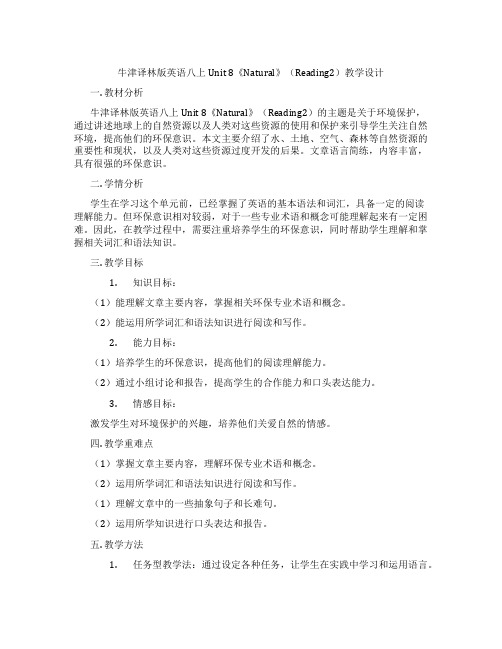
牛津译林版英语八上Unit 8《Natural》(Reading2)教学设计一. 教材分析牛津译林版英语八上Unit 8《Natural》(Reading2)的主题是关于环境保护,通过讲述地球上的自然资源以及人类对这些资源的使用和保护来引导学生关注自然环境,提高他们的环保意识。
本文主要介绍了水、土地、空气、森林等自然资源的重要性和现状,以及人类对这些资源过度开发的后果。
文章语言简练,内容丰富,具有很强的环保意识。
二. 学情分析学生在学习这个单元前,已经掌握了英语的基本语法和词汇,具备一定的阅读理解能力。
但环保意识相对较弱,对于一些专业术语和概念可能理解起来有一定困难。
因此,在教学过程中,需要注重培养学生的环保意识,同时帮助学生理解和掌握相关词汇和语法知识。
三. 教学目标1.知识目标:(1)能理解文章主要内容,掌握相关环保专业术语和概念。
(2)能运用所学词汇和语法知识进行阅读和写作。
2.能力目标:(1)培养学生的环保意识,提高他们的阅读理解能力。
(2)通过小组讨论和报告,提高学生的合作能力和口头表达能力。
3.情感目标:激发学生对环境保护的兴趣,培养他们关爱自然的情感。
四. 教学重难点(1)掌握文章主要内容,理解环保专业术语和概念。
(2)运用所学词汇和语法知识进行阅读和写作。
(1)理解文章中的一些抽象句子和长难句。
(2)运用所学知识进行口头表达和报告。
五. 教学方法1.任务型教学法:通过设定各种任务,让学生在实践中学习和运用语言。
2.合作学习法:鼓励学生小组讨论,共同完成学习任务。
3.情境教学法:创设各种情境,让学生在真实的环境中学习和运用语言。
4.启发式教学法:引导学生主动思考,发现问题,解决问题。
六. 教学准备1.教师准备:(1)熟悉教材内容,明确教学目标。
(2)设计各种教学活动和方法。
(3)准备相关教学资源和材料。
2.学生准备:(1)预习教材,了解基本内容。
(2)查阅相关资料,了解环保知识。
七. 教学过程1.导入(5分钟)教师通过展示一些关于自然环境的图片,引导学生谈论自己对自然环境的看法,激发学生的学习兴趣。
牛津译林版英语八上Unit 8《Natural》(Reading2)ppt课件1

1.Timmy was in the street when the
earthquake started. __F___
2. At first,Timmy heard a loud
noise like thunder.
___F__
3. People ran in the same direction in
Eg: 我们听到这个令人兴奋的消息很激动。
We are excited at the exciting news.
1. Try to say something about Timmy’s story.
2. Remember the main phrases the text.
the street.
__F__
write down “T” or “F”.
4. Timmy was trapped in a dark place
after the earthquake stopped. __T___
5. There was not enough space for
Timmy to pull himself through. __T___
was sleeping 是过去进行时态 过去进行时结构:was/ were + doing Eg: 昨天三点他正在看电视。 He was watching TV at 3 o’clock yesterday. 2. I tried my best to run out too. try one’s best to do sth 意为“尽力去做某事” Eg: 他尽力保持安静。
thunder
• people
牛津译林版八年级英语上册《nit 8 Natural disasters Integrated skills》优质课课件_0

cold water for about ten minutes.
2. Should we put any cream on the burn? No, we shouldn't. We should go and see the doctor.
Introduce what we should do when we burn our hands.
If we bat home,
We should first......., and then...... After that, we should......
Simon: Hide under a _s_tr_o_n_g_ desk or table. Stay away from aw__in_d_o_w.
Annie: What should we do to protect ourselves from traffic accidents?
Simon: We should always follow __tr_a_ff_ic__r_u_le_s____. Moreover, it’s dangerous to sit, walk or ride a bicycle on _r_a_i_lw_a_y_s______.
Tip: Use what we learnt today and you can also add your own ideas.
Fires
Floods
Earthquakes
A: What should we do when/if....? B: We should…. A: What mustn't we do? B: We mustn't....
牛津译林版八上《Unit8 Natural disasters》(Integrated skills)课件
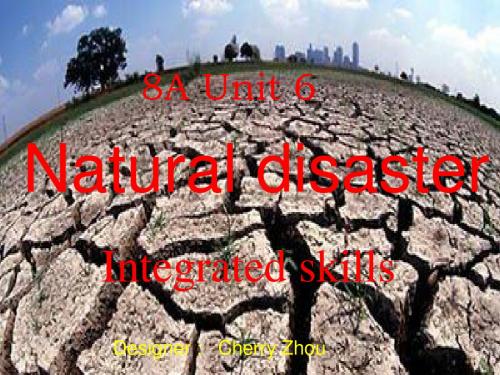
Mrs. Su:
What did they do?
call 110 hotline
mobile phone
snowstorm crashed into
trapped in
policemen
7.45p.m. sent them to
What happened in Britain?
There was a heavy storm and Vivien’s school caught fire.
What about London? Do you have snowstorms there?
Please e-mail me soon.
Sandy
Retell the accident
who
where
Starlight Street
Sunshine Town
How did they hurt?
8A Unit 6
Natural disaster
Integrated skills
Designer : Cherry Zhou
rainstorm
thunder and lightning
typhoon
sandstorm
snowstorm
Accident: Their car crashed into (1)__a_t_re_e_. They are(2)_t_r_ap_p_e_d__in the car.
This morning I read a newspaper article about a car accident.
A man named S_u__N_i_ng called the 110 hotline at_7_.4__0_p_.m_u.sing his mobile phone. His car crashed into_a__tr_e_e_ while he was driving in ___th_e_s_n_o_w__st_o_r_m____ He and his wife were t_r_a_p_p__ed in the car. The snow was __h_e_a_v_y_and it covered everything .The policemen arrive at7._4_5_p_._m__. and they sent them to hospital at7_.5_5_p__.m_ Mr. Su felt _c_o__ld__and _fr_i_g_h_t_e_n_e_d_but he was not hurt. Mrs. Su hurt her __l_e_f_t_l_e_g_but it was not very serious.
牛津译林版英语八年级上册Unit 8《Natural》(Reading1)ppt课件1

3.You can stay in the corner. Remember : the most important thing is to protect your head.
If you are trapped in the earthquake:
Calm down. Don’t eat your things quickly if you have. Try to find your way out. Shout for help.
Brainstorm
shake
bombs fall down
run wildly
earthquake
frightened in fear
scream = shout loudly
run in all directions
/di‘rekʃn/
The Taiwan earthquake
Time: 1999 Situation:
1.What was Timmy doing when the earthquake started ?
He was sleeping.
2. How did people save Timmy at last?
They quickly moved away the bricks and stones.
bombs
see
fall down
run in all directions wildly
do
try his best to run out
Task Three
be trapped
/æ/
What did Timmy do to save himself after Para3-5 he was trapped?
【译林版】八年级英语上册:Unit 8 Natural disasters Integrated s
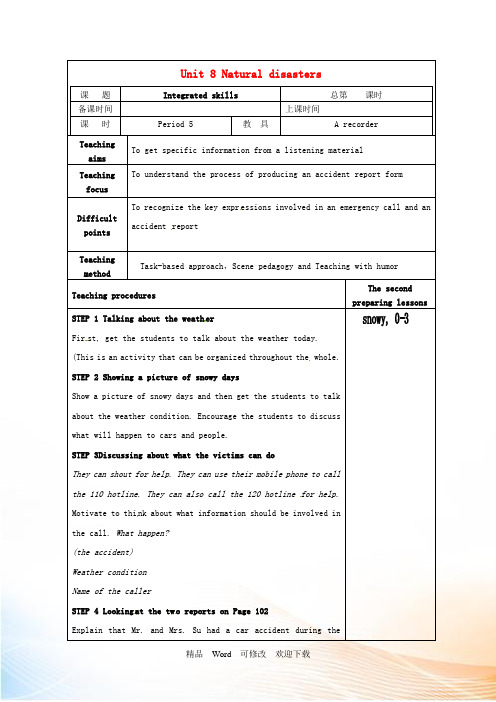
Unit 8 Natural disasters课题Integrated skills 总第课时备课时间上课时间课时Period 5 教具 A recorderTeachingaimsTo get specific information from a listening material TeachingfocusTo understand the process of producing an accident report formDifficult points To recognize the key expr essions involved in an emergency call and an accident reportTeachingmethodTask-based approach,Scene pedagogy and Teaching with humorTeaching proceduresThe second preparing lessonsSTEP 1 Talking about the weath erFir st, get the students to talk about the weather today. (This is an activity that can be organized throughout the whole. STEP 2 Showing a picture of snowy daysShow a picture of snowy days and then get the students to talk about the weather condition. Encourage the students to discuss what will happen to cars and people.STEP 3Discussing about what the victims can doThey can shout for help. They can use their mobile phone to call the 110 hotline. They can also call the 120 hotline for help. Motivate to thi nk about what information should be involved in the call. What happen?(the accident)Weather conditionName of the callerSTEP 4 Looking at the tw o reports on Page 102Explain that Mr. and Mrs. Su had a car accident during thesnowstorm. Ask students to look at the two reports on Page 102 and explain that the report form in Part A1 is from the 110 hotline where as the report in Part A2 is made by the policemen after they rescued Mr. and Mrs. Su.Explain the items in the report form and make sure that they can understand it.STEP 5 Playing the tape two timesPlay the tape two times for the students to find as much information as possible. And then fill in the report form. And of c ourse, it is impossible for them to complete the table by listening.Get them to read the repo t below and find more information. (One thing to mention here is that the teacher can also get students to understand how the victims through their voice. If possible, get them to imitate it. )STEP 6Calling the police for helpDivide the students into two groups. Sup pose that they are in different situations and encourage them to call the police for help.Step7Home workFinish off the exercise s in boo ksTeachingnotes。
- 1、下载文档前请自行甄别文档内容的完整性,平台不提供额外的编辑、内容补充、找答案等附加服务。
- 2、"仅部分预览"的文档,不可在线预览部分如存在完整性等问题,可反馈申请退款(可完整预览的文档不适用该条件!)。
- 3、如文档侵犯您的权益,请联系客服反馈,我们会尽快为您处理(人工客服工作时间:9:00-18:30)。
A3. Simon’s cousin Annie is asking Simon about the talk. Help him answer Annie’s questions. Listen to the talk again and check your answers. Annie: What did you learn from yesterday’s talk, Simon? Simon: We learnt a lot about keeping ourselves safe from fires, floods, accidents. earthquakes and traffic _____________
Annie: Well, what should we do when
there’s a flood?
high ground Simon: We should get to ____________. Remember that we shouldn’t
walk through the flood water. ______
Annie: I see. What should we doppens?
strong desk or Simon: Hide under a _______ table. Stay away from a ________. window Annie: What should we do to protect ourselves from traffic accidents? Simon: We should always follow ___________. traffic rules Moreover, it’s dangerous to sit, walk or ride a bicycle on __________. railways
disaster or an accident. The students
are attending a talk called “Away from
danger” at Sunshine Hall. Listen to the
talk and help Simon complete his notes.
110-Police
119-Fire
120-Hospital
122-Traffic
119-Fire —————
__________ 122-Traffic
120-Hospital ___________
110-Police ___________
A2. It is important to know how to protect ourselves when there’s a
Danger Tips Fires : Try to get out as soon as possible Cover your mouth and nose with a wet towel to protect yourself thick smoke from ___________ Stay ____ low to the ground go back into the building Never ________ on fire high ground and stay Floods: Get to _____ here walk through the flood Do not _______ water
Earthquake: ______ Hide under a strong desk or table to protect yourself Do not stand near a window ________. Traffic : Always ________ follow traffic rules. accidents Look ______, left right and then left when you cross the road Do not sit, ______or ride walk your bicycle on railways.
Annie: Really? What should we do if our building is on fire? Simon: We should try to ______ get out as soon as possible. Annie: How can we protect ourselves from the thick smoke? Simon: We should use a _________ wet towel to cover our mouth and nose and stay ____ low to the ground.
A snowstorm can cause traffic accidents. When they are in danger, they should stay calm and dial 122 for help. Now please talk about the other three pictures in groups of four. Please describe each picture and find out which number they should dial.
Integrated skills
Words and expression review
as…as possible towel rule railway burn 尽可能 n. 毛巾;浴巾 n. 规则 n. 铁路 n. 烧伤,烫伤,灼伤
A. Away from danger
Many people like snow because it looks really beautiful, but sometimes it can cause problems. What problems can it cause? Please take a look at the pictures on page 99. Which one is about a traffic in a snowstorm? What happened to them? What should they do?
